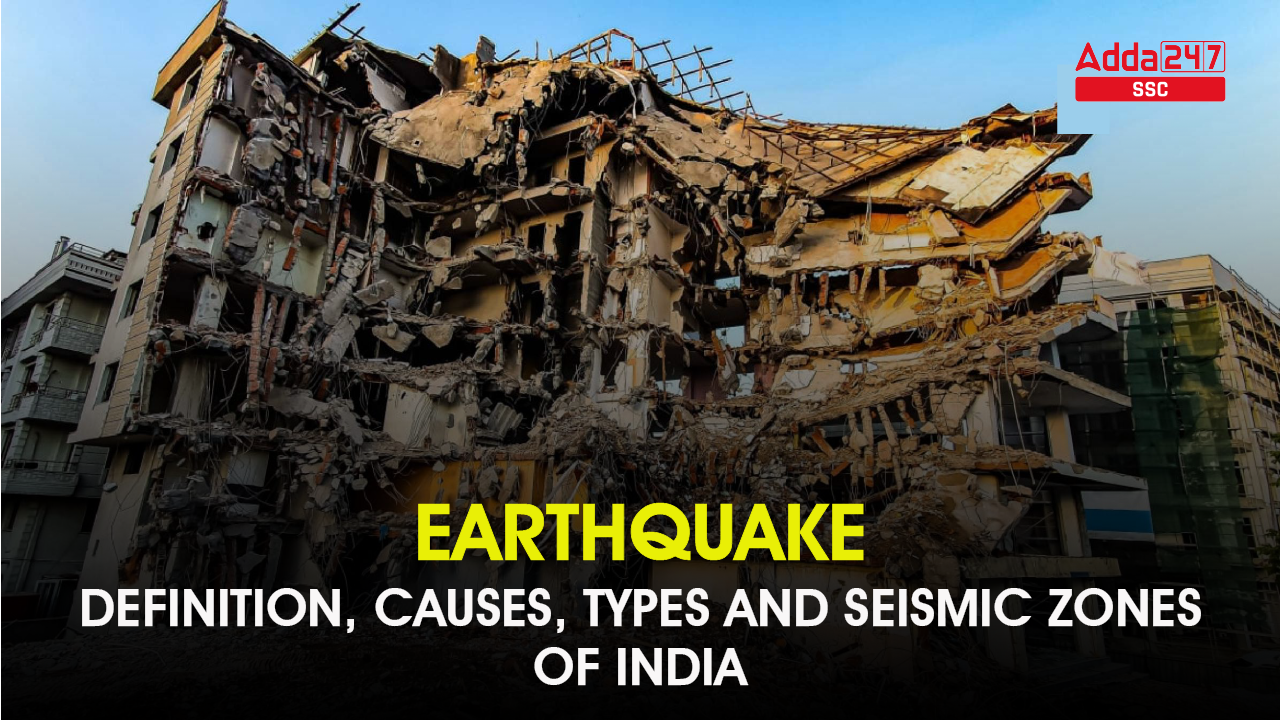Earthquake: Definition
An earthquake can be defined as a sudden shaking in the earth’s crust due to the movement in the plates resulting in the release of sudden energy and the formation of seismic waves. When a part of the earth’s surface starts moving backward and upwards, tremors are observed on the surface of the earth and hence called an earthquake. Earthquake meaning can be simply said as when Earth ‘quakes’. The earth’s crust is made up of different parts known as plates. In this article, we will cover everything you need to about earthquakes including the causes of an earthquake, facts, and earthquake zones in India.
Earthquakes can vary in magnitude, ranging from minor tremors that may go unnoticed to major quakes that can cause widespread destruction. The effects of an earthquake depend on factors such as its magnitude, depth, distance from populated areas, and the local geological conditions.
In addition to ground shaking, earthquakes can trigger secondary hazards such as tsunamis (if the quake occurs under the ocean), landslides, avalanches, and aftershocks. These can further contribute to the overall impact and damage caused by the initial earthquake.
Types of Earthquake
There are various types of earthquakes that can be witnessed:
- Tectonic earthquake: It is the most common form of an earthquake. It is generally caused by the movement of plates present in the earth’s crust known as tectonic plates.
- Volcanic earthquake: This type of earthquake is less common as compared to the tectonic earthquake. These types of earthquake happen before or after the explosion of a volcano. It is generally caused due to the magma leaving the volcano which is filled by rocks being pushed to the surface.
- Collapse earthquake: This type of earthquake occurs in underground mines. The main cause can be the pressure generated within the rocks.
- Explosion earthquake: This type of earthquake is artificial which means it is generated by man-made activities. High-density explosion on the ground such as nuclear explosions is the primary cause of explosion earthquake.
Force: Definition, Unit, Formula, Effects, And Types
Cause of an Earthquake
Earth’s crust consists of several large and small tectonic plates around the earth. The Major earthquake happen in the belts coinciding with the tectonic plates and the boundaries of these plates act as an epicenter. These plates form 3 types of boundaries, they move towards each other (a convergent boundary), apart from each other (a divergent boundary), or past each other (a transform boundary). The continuous movements of these tectonic plates along the boundaries build up pressure on both sides of the boundaries until the stress is great and is released in a sudden jerky movement. Hence, seismic waves created due to the energy released, travel through the surface of the earth causing the shakes known as an earthquake.
Seismic Zones of India
The Indian subcontinent is divided into four seismic zones namely II, III, IV, and V based on the seismicity, earthquakes that occurred in the past, and tectonic setup of the region. As per the geographical data, almost 54% of India’s land is prone to earthquakes. Zone 5 covers the areas with the highest risk of getting an earthquake while Zone 2 is a considerably low -damage risk zone.
1. Zone 2: This zone covers parts of Jammu and Kashmir, Himachal Pradesh, Uttarakhand, and the North-Eastern states. It is considered a moderate seismic zone with a low probability of earthquakes.
2. Zone 3: This zone covers parts of Gujarat, Rajasthan, Haryana, Delhi, Uttar Pradesh, Bihar, West Bengal, and parts of the North-Eastern states. It is considered a moderate to high seismic zone with a moderate probability of earthquakes.
3. Zone 4: This zone covers parts of Jammu and Kashmir, Himachal Pradesh, Uttar Pradesh, Bihar, Sikkim, parts of the North-Eastern states, and the Andaman and Nicobar Islands. It is considered a high seismic zone with a high probability of earthquakes.
4. Zone 5: This zone covers the entire northeastern region, parts of Jammu and Kashmir, Himachal Pradesh, Uttar Pradesh, Bihar, Gujarat, Maharashtra, and the Andaman and Nicobar Islands. It is considered a very high seismic zone with a very high probability of earthquakes.
Terms Related to Earthquake
- Seismology: It is the branch of Geology dealing with the study of an earthquake.
- Seismic Waves: These are the waves of energy caused by the earthquake that travels through the layers of the earth.
- Epicenter: It is the point on the ground surface that is closest to the focus.
- Focus or Hypocenter: The place where the origin of seismic waves takes place beneath the earth’s surface is called the focus of an Earthquake.
- Seismograph: The instrument on which the seismic waves are recorded is known as a seismograph.
- Richter Scale: The instrument used to measure the magnitude of an earthquake.
- Mercalli Scale: The instrument used to record the intensity of an earthquake.
- Types of seismic waves: There are 3 types of seismic waves namely Primary waves, secondary waves, and Surface or long waves.
| You may also like to read: | |
| Parliament of India | Dams in India |
| Union Territories in India | Largest State in India |



 Upcoming Government Exams, Complete Govt...
Upcoming Government Exams, Complete Govt...
 Govt Jobs 2025, Latest Upcoming Governme...
Govt Jobs 2025, Latest Upcoming Governme...
 SSC Exam Calendar 2025–26 Out, Check All...
SSC Exam Calendar 2025–26 Out, Check All...









